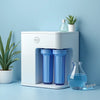
Water Purifier with Reverse Osmosis and Ultraviolet Guide
, by Ysvara Lifestyle, 13 min reading time

, by Ysvara Lifestyle, 13 min reading time
Updated on: 2025-11-06
A water purifier with reverse osmosis and ultraviolet combines two proven technologies to give your kitchen a high-performance filtration system. In simple terms, the RO membrane reduces dissolved solids and the UV sterilizer treats the water at the final stage. Many households choose an RO UV water purifier because they want consistent taste, clarity, and convenience. If you’re comparing options, a reverse osmosis UV water filter offers a strong balance of filtration depth and low-effort upkeep, making it a versatile solution for home use.
With the right configuration, you’ll enjoy crisp-tasting water for cooking, brewing, and everyday drinking. Households with varying source water quality value how these systems handle changing conditions, while features like a TDS controller water purifier help fine-tune the taste. If you’ve been debating whether to install a system under the sink or opt for a compact countertop, you’ll find an RO UV setup that fits your space and goals.
Explore Ysvara to see curated picks that match everyday kitchens and apartments without overcomplicating installation or maintenance.
Once installed, the upgrade is immediate. Cooking pasta, rice, and soups with cleaner water helps preserve natural flavors. Coffee and tea can taste more consistent, so you waste fewer beans or leaves trying to get the brew right. Families who prepare baby-friendly meals appreciate the confidence of a system that treats both dissolved solids and microbes without adding steps to their routine. A compact unit is also a smart choice in small kitchens where every inch counts.
“Our tap taste was unpredictable. After switching to an RO UV unit, our cold water and coffee both taste cleaner. Maintenance reminders make it easy.” — Priya A.
“Space is tight in our flat, but the under-sink installation was straightforward. The flow rate suits our family of four.” — Daniel T.
“We like that the TDS controller lets us tune the taste. It’s a small feature with a big payoff.” — Maya D.
Ready to compare configurations? Check current options and availability on the collections page.
One of the biggest benefits of a water purifier with reverse osmosis and ultraviolet is predictable upkeep. Most systems follow a simple schedule: pre-filters first, RO membrane next, and UV lamp at recommended intervals. Your goal is steady performance with minimal downtime.
Here’s a practical way to think about the maintenance cost of a water purifier with reverse osmosis and ultraviolet:
Result: An RO UV system makes costs more predictable. Better yet, on-time maintenance supports taste and clarity so you get more value from every glass.
For more buying and care tips, visit the news and guides.
Choosing a water purifier with reverse osmosis and ultraviolet is a smart way to simplify your routine while elevating the taste and clarity of your drinking and cooking water. If you host often or brew daily, you’ll notice the consistent results right away. Balance membrane capacity with your daily usage, confirm UV lamp lifespan, and consider a TDS controller if you want a customizable profile. Keep a small inventory of pre-filters on hand, mark your calendar, and you’ll enjoy smooth, set-and-forget performance for the long term.
When you’re ready to take the next step, browse curated options on the collections page or start with the home page for the latest updates and availability.
It depends on your goals. Reverse osmosis focuses on reducing dissolved solids and many other impurities, while UV treats microorganisms at the final stage. If you want broad coverage in one unit, combining RO and UV is a practical, all-in-one approach that many households prefer for consistent taste and clarity. If your source water is already very low in dissolved solids, you might prioritize UV; if taste and dissolved solids are your main concern, RO is key. Many buyers choose a combined system to cover both needs.
Follow your model’s manual, but a common pattern is more frequent pre-filter changes, less frequent RO membrane replacement, and a scheduled UV lamp replacement at set intervals. Usage, incoming water characteristics, and tank size all play a role. Most modern systems include maintenance indicators to remove guesswork, and a simple calendar reminder helps keep everything on track.
Yes, a TDS controller lets you blend a small amount of source water with RO-purified water to reach a target TDS level. Many people prefer the resulting taste profile for everyday drinking and brewing. It’s a user-friendly way to fine-tune flavor without adding complex steps to your routine.
Match capacity to your household. Consider how many people are at home, how often you cook, and whether you fill large bottles or kettles frequently. A higher-capacity membrane, paired with an appropriate storage tank, helps maintain a comfortable flow rate during busy times like mornings and dinner prep.
Ysvara Lifestyle curates practical, design-forward solutions for modern homes, with focused expertise in RO UV water purifier systems. Our guides aim to simplify complex choices and help you select the right configuration the first time. Thanks for reading, and feel free to reach out anytime with questions.
The content in this blog post is intended for general information purposes only. It should not be considered as professional, medical, or legal advice. For specific guidance related to your situation, please consult a qualified professional. The store does not assume responsibility for any decisions made based on this information.




